Neurofibromatosis Type 2 (NF2)
What You Need to Know
- Neurofibromatosis type 2, or NF2, is a condition that causes tumors to arise on nerves, particularly those in the skull and spine, though other nerves can be affected.
- Vestibular schwannomas (also called acoustic neuromas) are tumors that occur in most people with NF2; they affect the nerves that help with balance and hearing.
- It is caused by a genetic change, and people with NF2 can pass the condition on to their children.
- Treatment consists of addressing symptoms, which can include hearing, balance and vision problems.
What is NF2?
NF2 is a neurologic disorder resulting from a change in the gene of the same name, the NF2 gene. When working properly, the NF2 gene prevents tumors from forming. In people with NF2, this gene is impaired and creates a greater risk of developing certain tumors. These tumors typically include vestibular schwannomas (also called acoustic neuromas), meningiomas and ependymomas, which can affect the brain and spinal cord, and schwannomas, which can affect peripheral nerves.
NF2 Symptoms
Although the abnormal changes in the NF2 gene may be present since birth, the symptoms of NF2 are most common in people in their late teens and early 20s. People with a mild form of NF2 might not notice any symptoms until age 40 or later.
Neurofibromatosis type 2 symptoms vary, but almost all people with NF2 develop vestibular schwannomas, benign nerve tumors, in both ears, which can cause:
- Dizziness
- Hearing loss, which may begin as early as the teenage years
- Tinnitus (ringing in the ears)
- Problems with facial expressions
- Issues with balance
- Difficulty walking
The eyes can be affected, too. Juvenile cataracts are often the first recognizable symptom of NF2 in childhood, and people with NF2 can also develop other types of eye problems related to the condition.
Skin symptoms are less common in NF2. Very rarely, people with NF2 have a few café au lait spots (tan-colored spots on the skin of irregular shape) or dermal schwannomas (raised bumps on the skin).
NF2, Tumors and Cancer
About 50% to 75% of people with NF2 will also develop benign meningiomas in the brain or along the spine. Ependymomas, which tend to develop inside the spine in about 20% of people with NF2, can sometimes be cancerous. Depending on the location of these tumors, they may result in a variety of symptoms as they grow, such as pain, numbness and weakness.
NF2 Diagnosis
The diagnostic criteria for NF2 has been established by a consensus of experts. A person is thought to have NF2 if they have vestibular schwannomas (acoustic neuromas) in both ears or if they have a vestibular schwannoma in one ear and one or several first-degree relatives with NF2.
There are additional factors that can lead to the diagnosis of NF2. Your physician might recommend a physical exam, imaging studies and an audiogram to assess hearing function. Genetic testing could also help confirm the diagnosis of NF2.
NF2 Gene: What Causes Neurofibromatosis Type 2?
Neurofibromatosis type 2 is caused by a change in the NF2 gene, which is found on chromosome 22. Some people have features of NF2 that are limited to only one part of their body. This is called mosaic NF2. Genetic testing for people with this form of NF2 can be more complicated.
How is NF2 inherited?
A person with NF2 may have inherited the genetic change from one of their parents, or the genetic change may arise in them spontaneously.
Whether the NF2 gene change was inherited from a parent or has just appeared, every person with the NF2 gene change has a 50% chance of passing this change on to their child.
Genetic testing for NF2
Genetic testing for the NF2 gene is available and can be coordinated for appropriate families. It is a good idea for anyone with questions about inheriting NF2, passing NF2 on to a child, or having genetic testing for NF2 to meet with a genetic counselor to learn more about their individual case.
Neurofibromatosis Type 2 Treatment
There is no cure for NF2, but treatment can manage symptoms.
- Balance problems can be addressed with vestibular training, physical therapy and occupational therapy.
- Those affected by hearing loss can learn alternative communication techniques such as sign language. A test called a brainstem auditory evoked response (BAER) can provide information to help guide your doctor toward a therapeutic approach. Hearing aids, implants (such as cochlear implants), prosthetics and other approaches may be able to improve hearing. Researchers are developing medicines to address these types of hearing loss.
- For tumors affecting the brain, spine and peripheral nerves, your doctor may recommend observation (regular monitoring) or, for those causing pain or other problems, surgery. Radiotherapy can address vestibular schwannomas. Drug treatments for NF2-related tumors are currently under investigation, and may provide more options in the future.
- People experiencing tinnitus may benefit from tinnitus retraining therapy and behavioral interventions.
- NF2-related pain and discomfort may respond to medication, meditation, acupuncture and behavioral approaches.
The Johns Hopkins Comprehensive Neurofibromatosis Center
The Johns Hopkins Comprehensive Neurofibromatosis Center is one of only a handful of centers in the world helping patients with neurofibromatosis 1 (NF1), neurofibromatosis 2 (NF2) and schwannomatosis. Learn how this multidisciplinary team of world experts treats patients with this syndrome across their lifespan.







